Sir John Monash, Personal Files Book 13, 1 June - 1 July 1916, Part 5
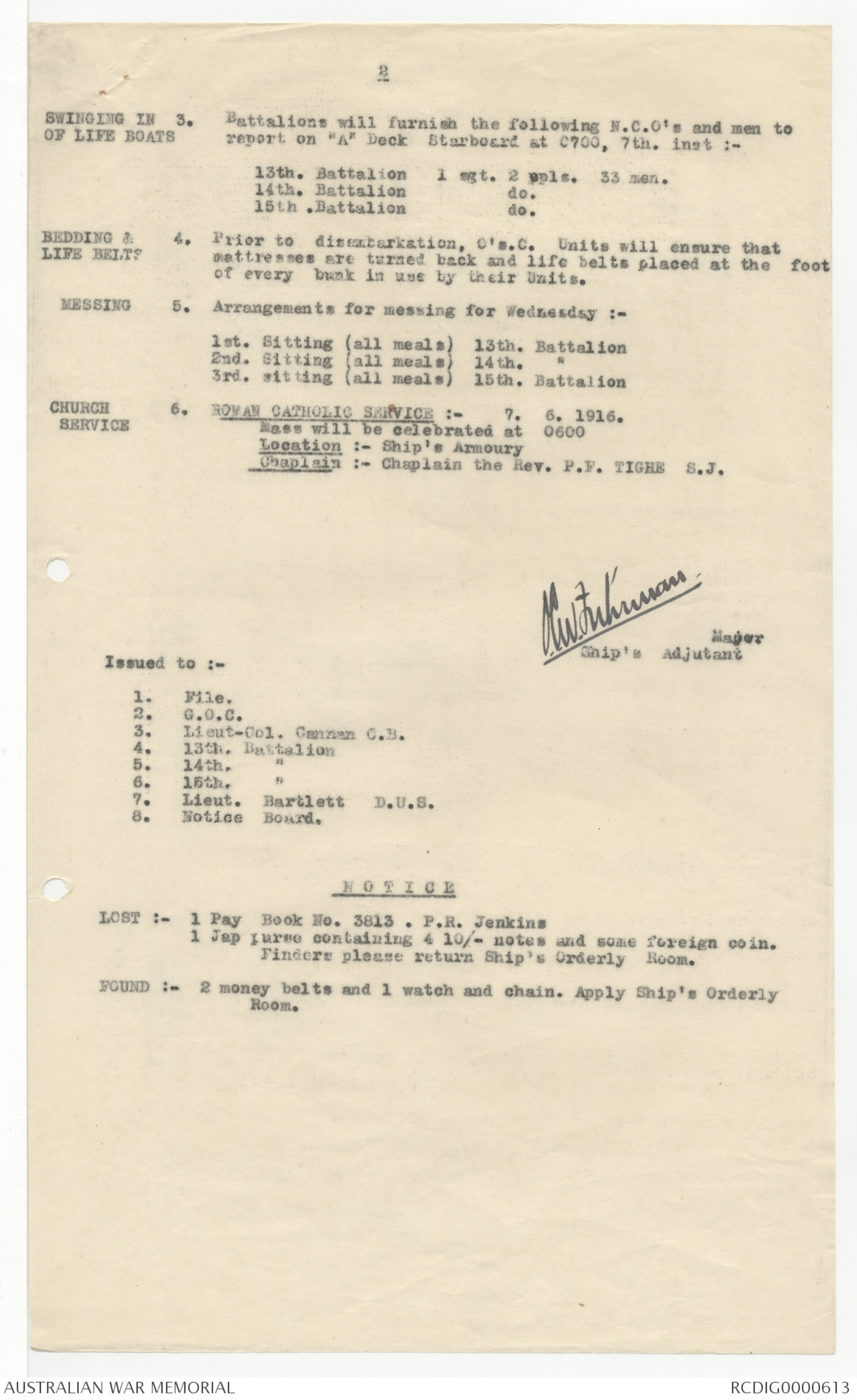
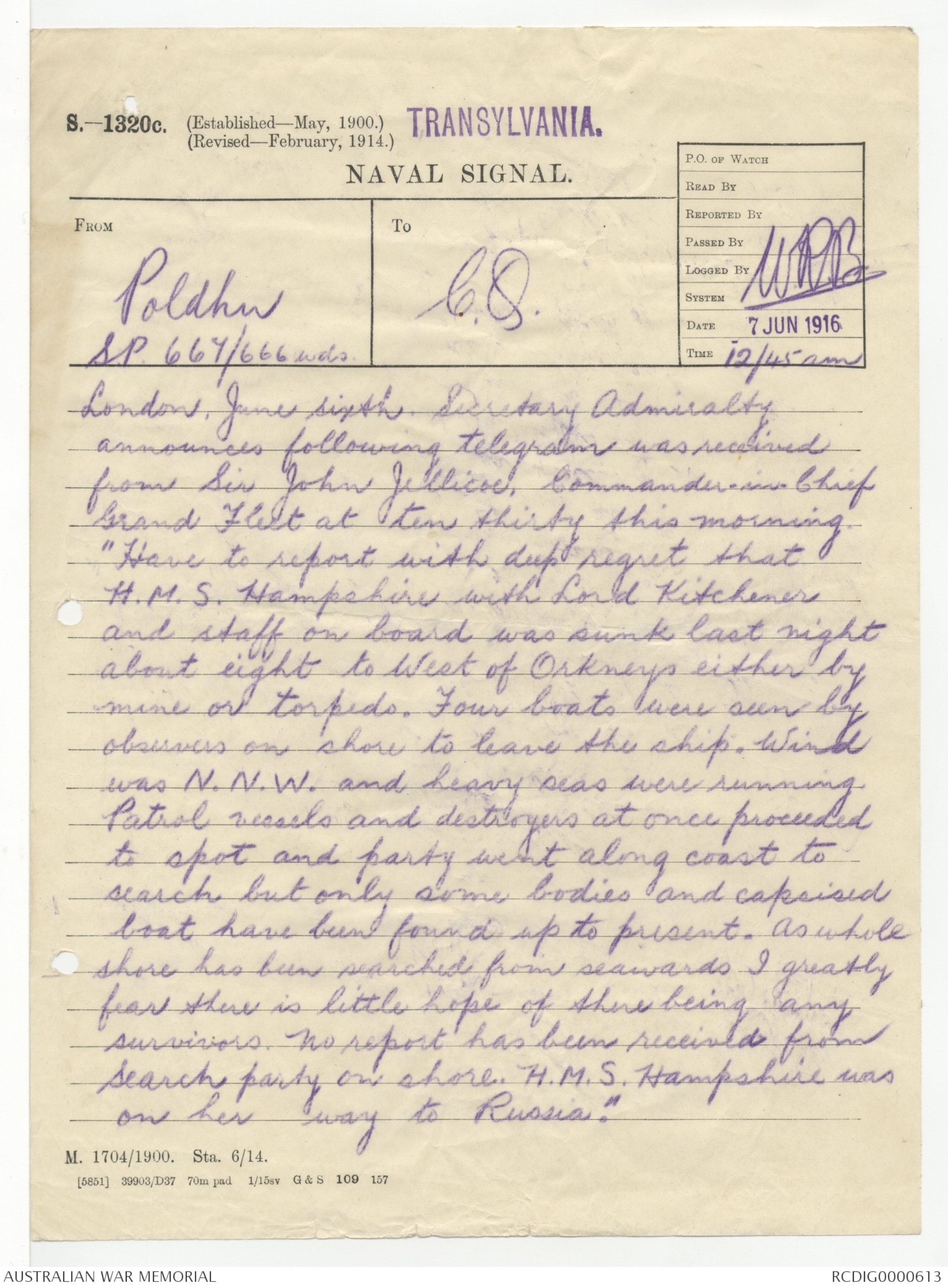
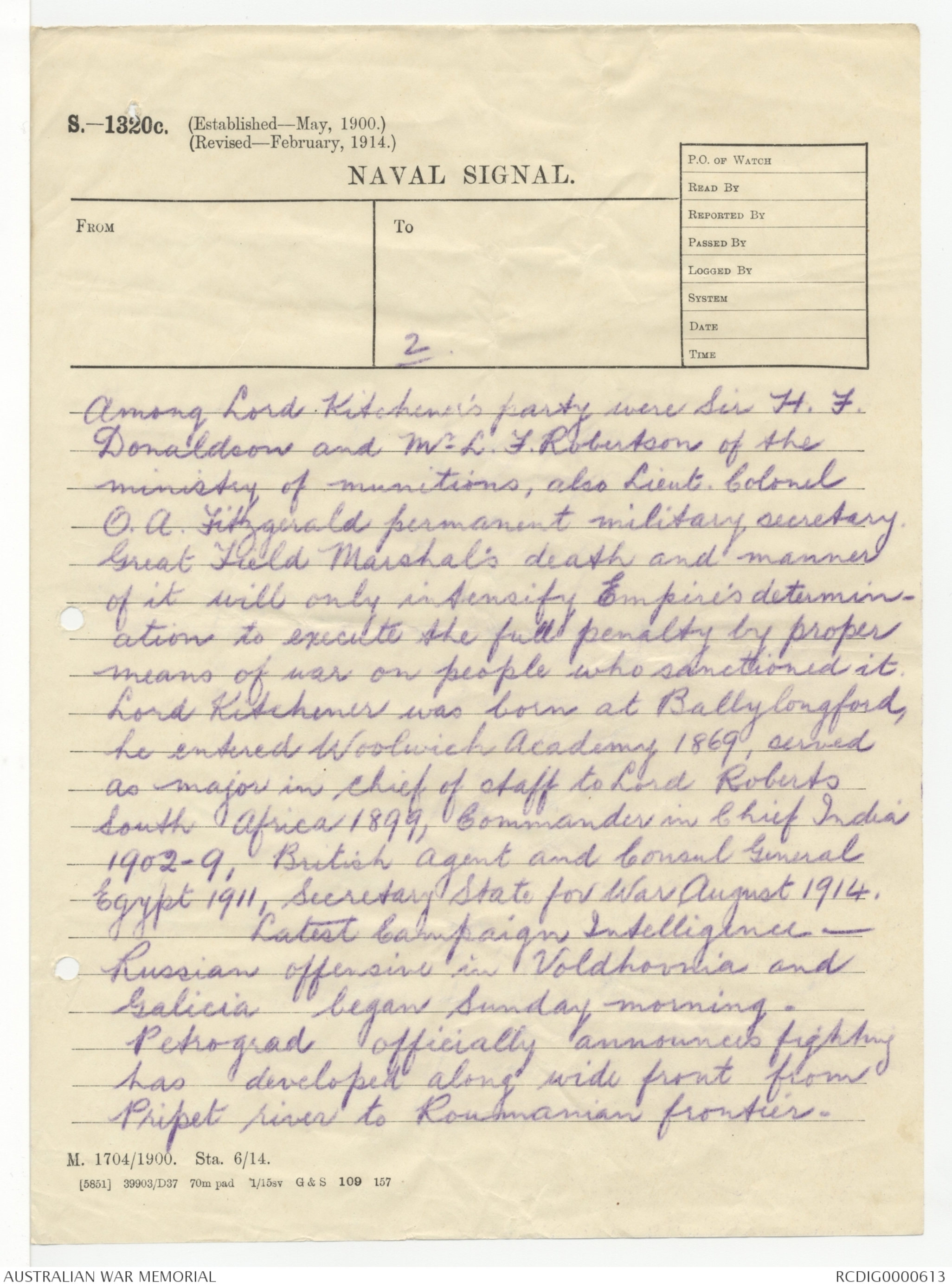
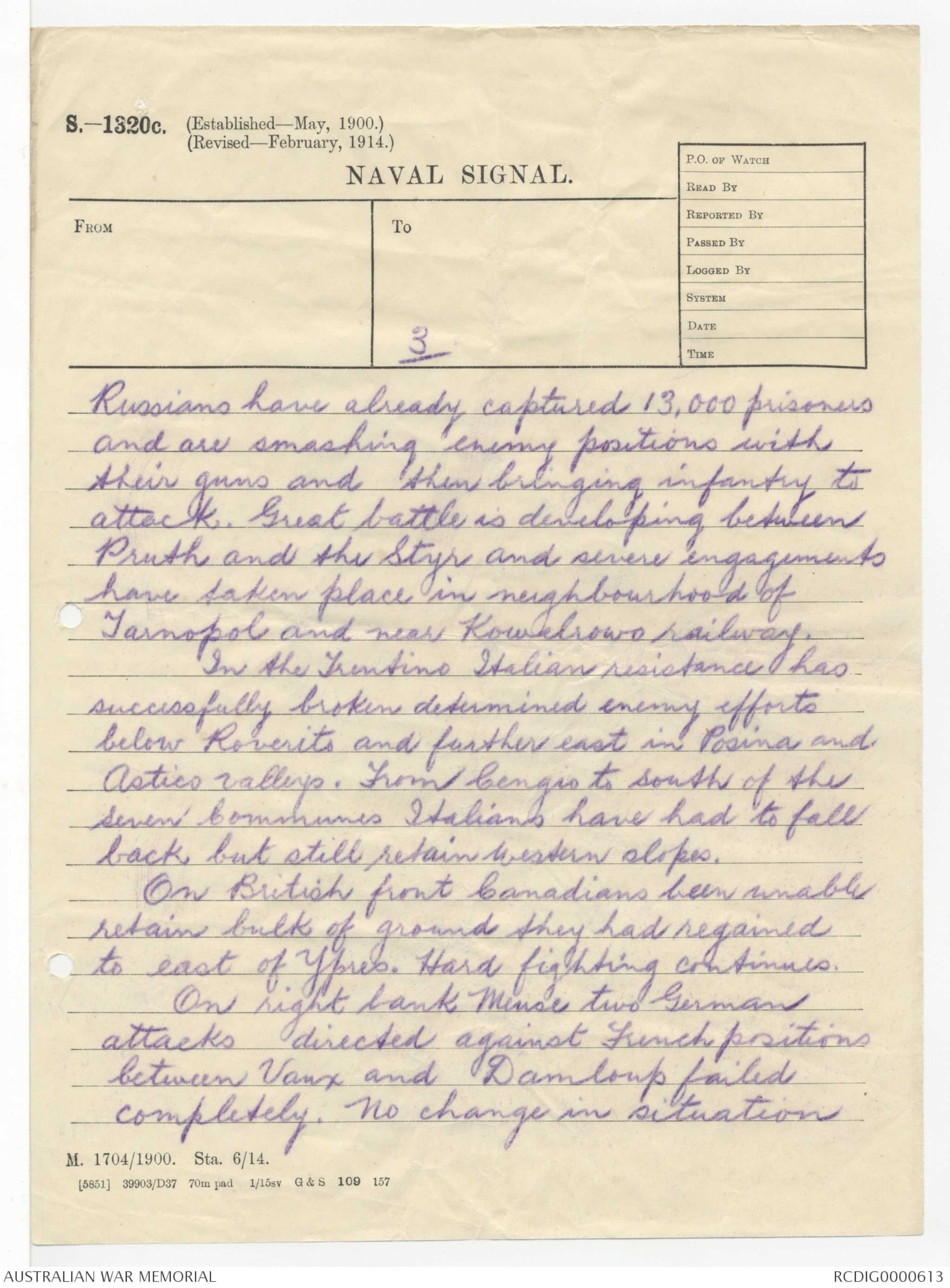
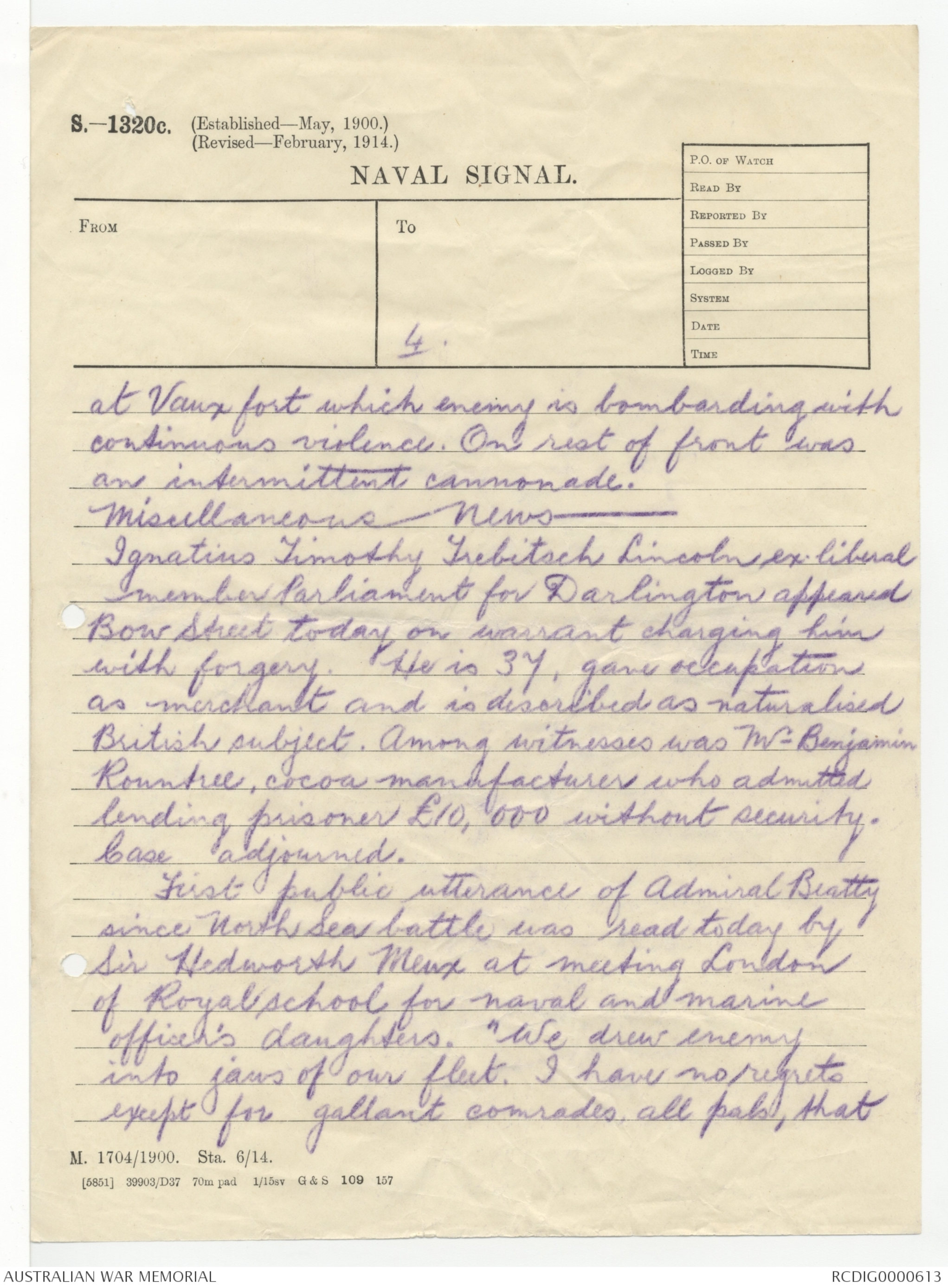
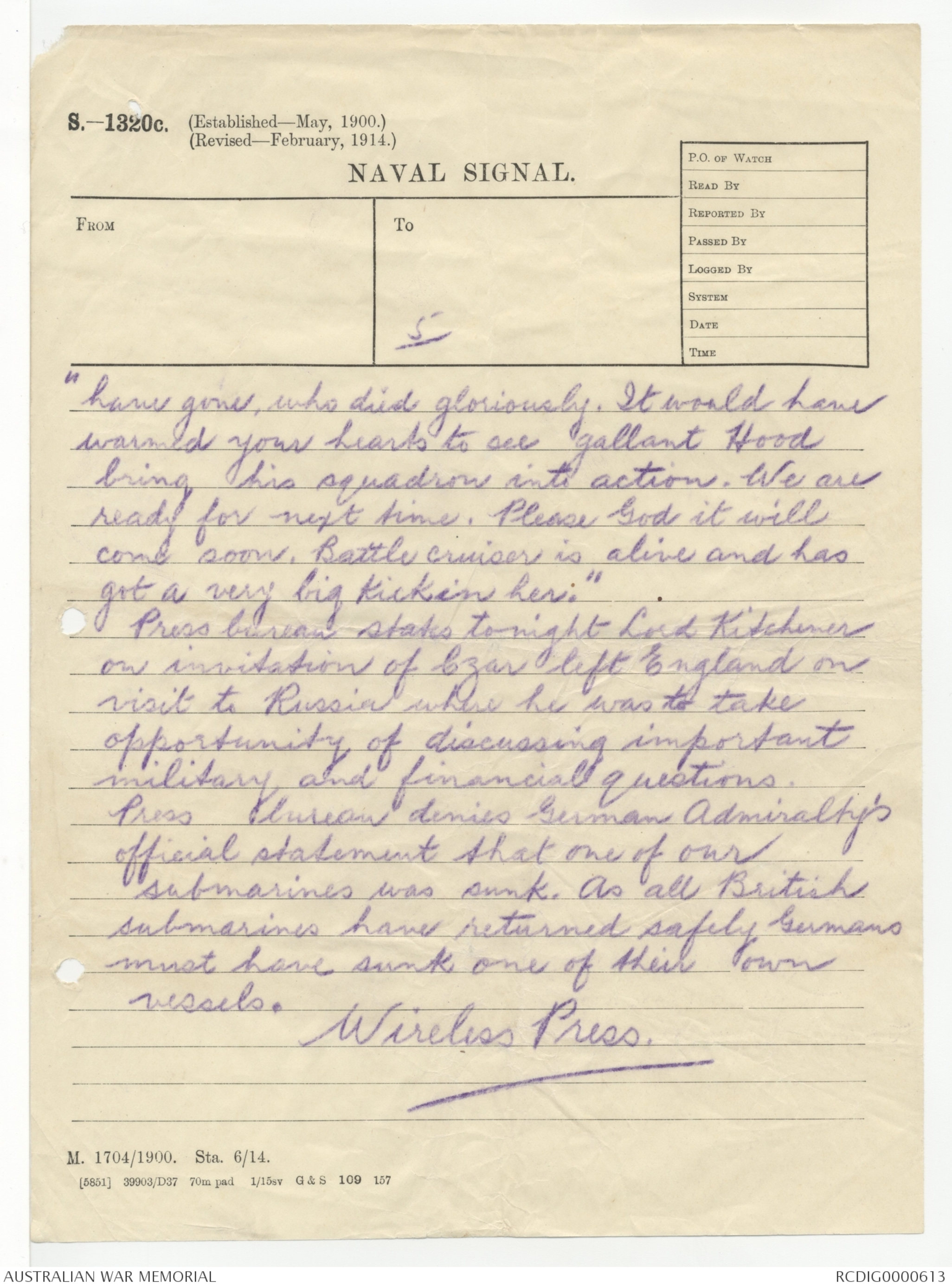
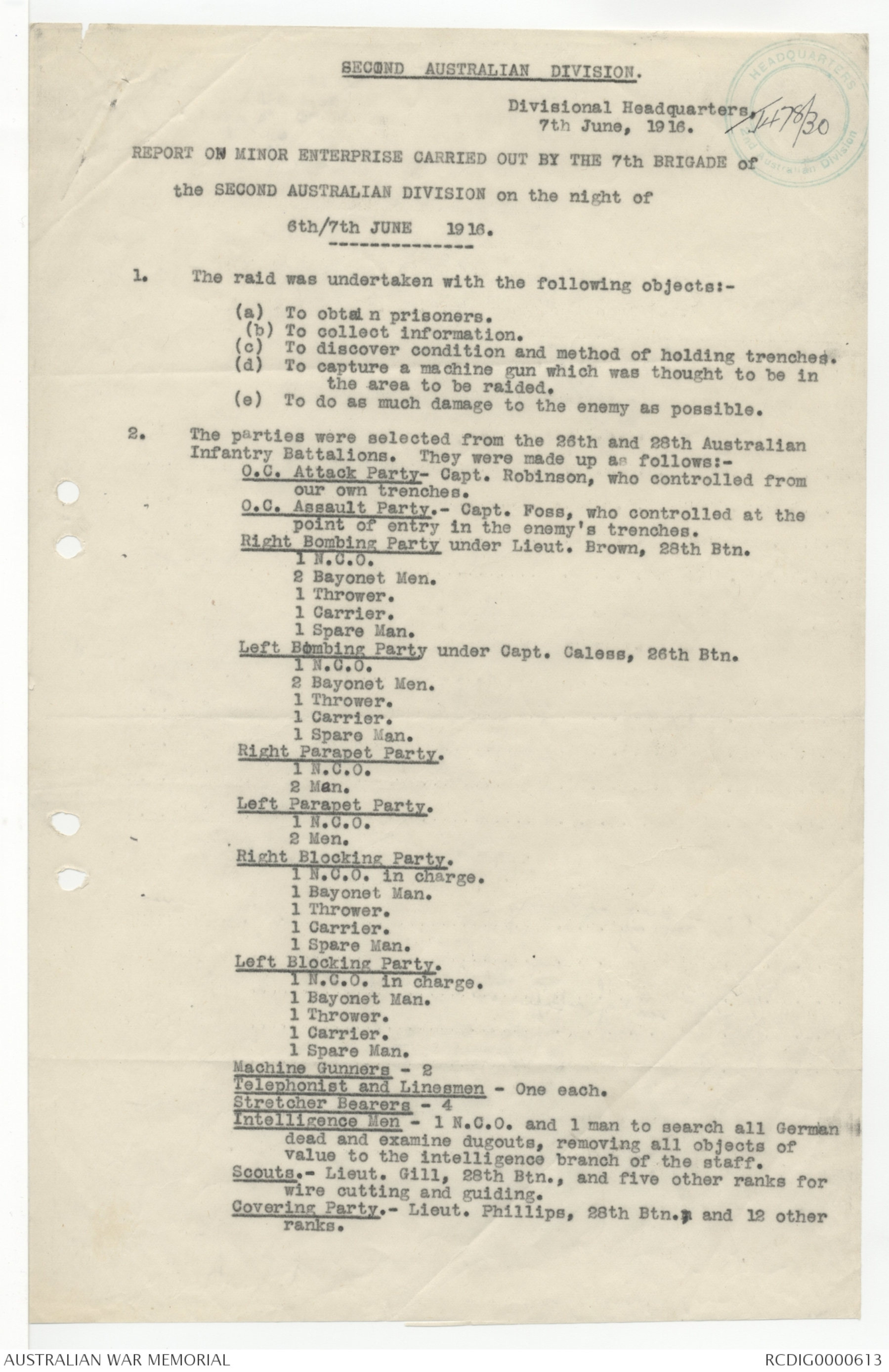
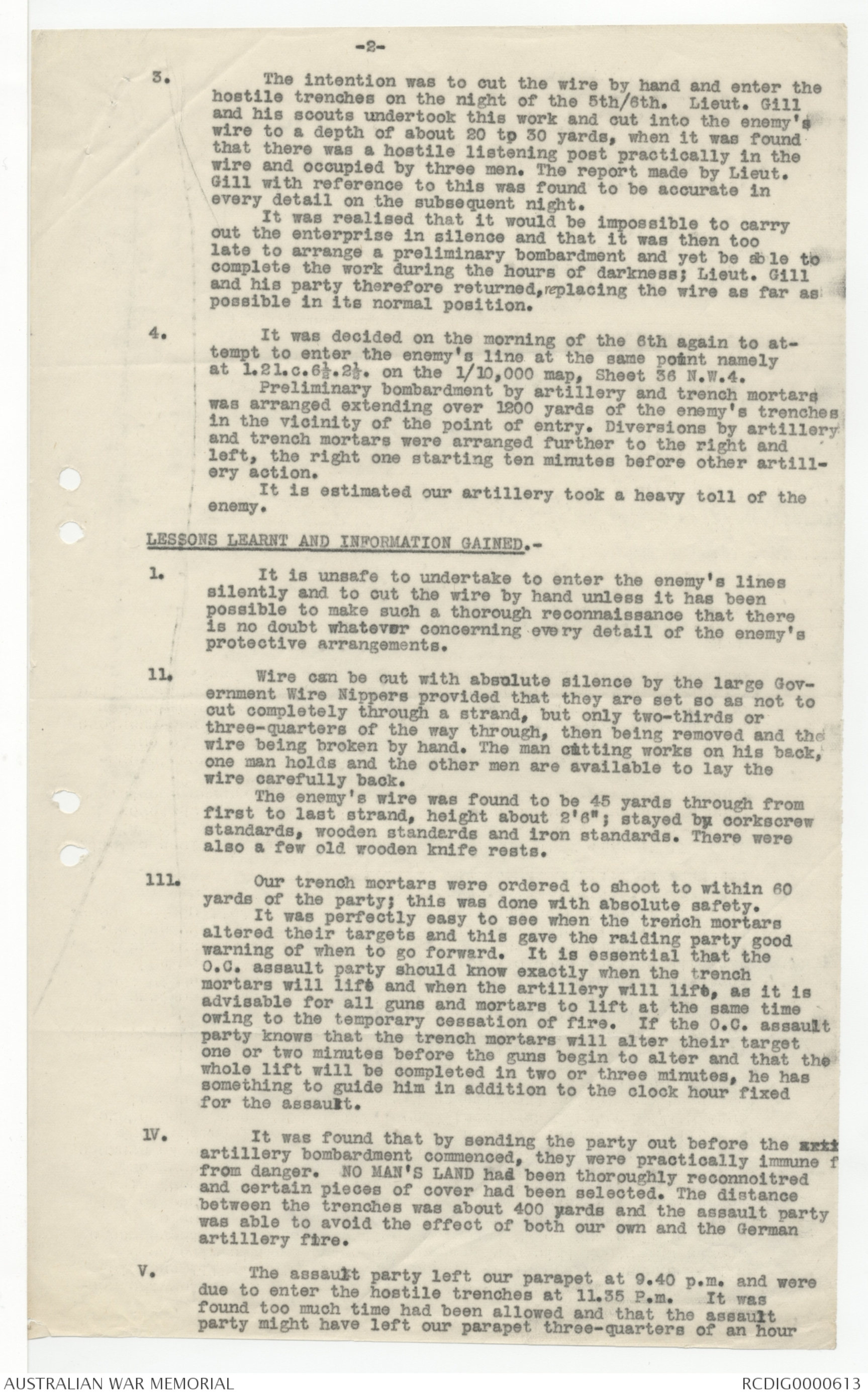
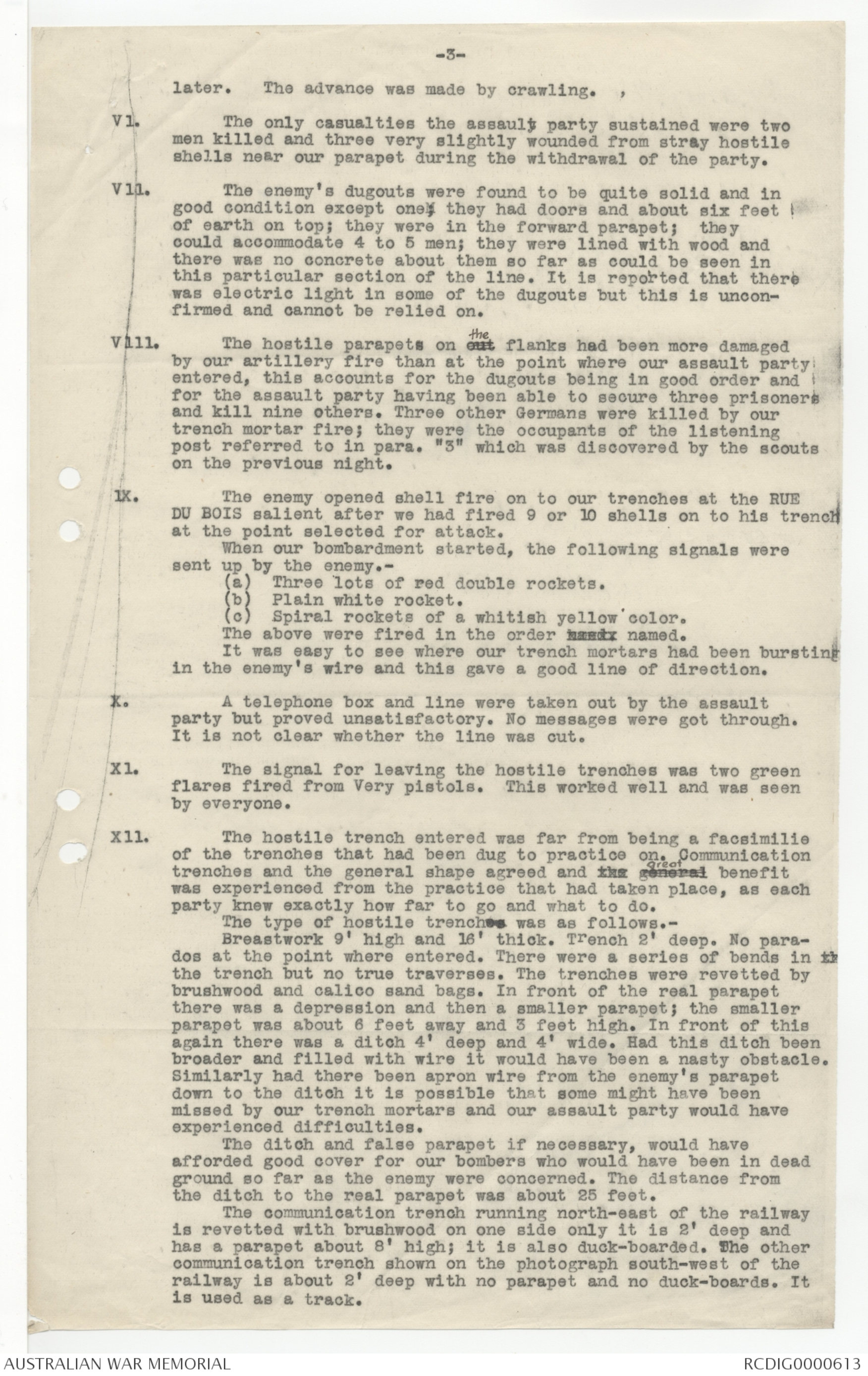
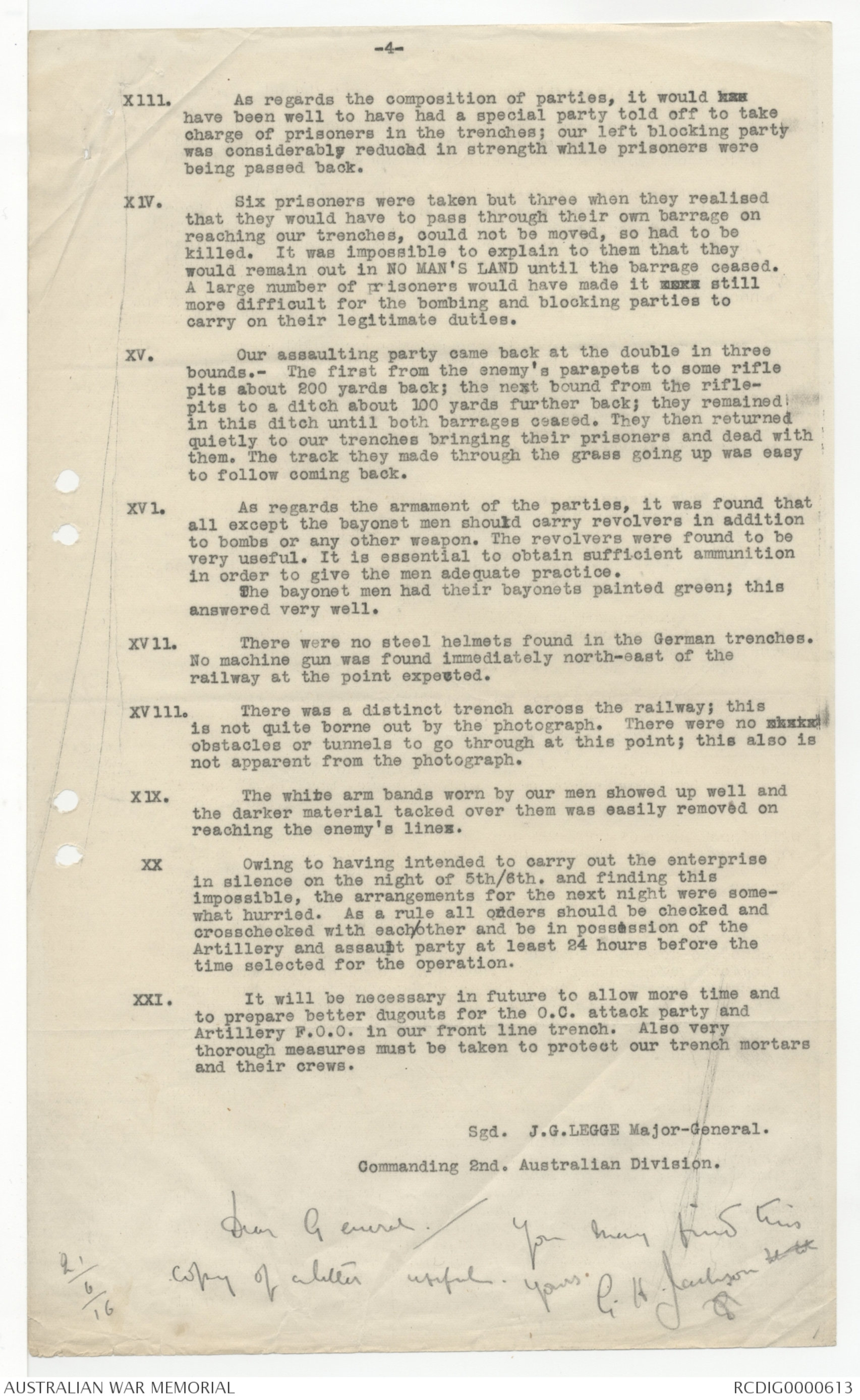
2
SWINGING IN
OF LIFE BOATS
3. Battalions will furnish the following N.C.O's and men to
report on "A" Deck Starboard at 0700, 7th inst :-
13th. Battalion 1 sgt. 2 cpls. 33 men
14th. Battalion do.
15th. Battalion do.
BEDDING &
LIFE BELTS
4. Prior to disembarkation, C's.C. Units will ensure that
mattresses are turned back and life belts placed at the foot
of every bunk in use by their Units.
MESSING
5. Arrangements for messing for Wednesday:-
1st. Sitting (all meals) 13th. Battalion
2nd. Sitting (all meals) 14th. "
3rd. Sitting (all meals) 15th. Battalion
CHURCH
SERVICE
6. ROMAN CATHOLIC SERVICE :- 7.6.1916.
Mass will be celebrated at 0600
Location:- Ship’s Armoury
Chaplain :- Chaplain the Rev. P.F. TIGHE S.J.
[[?H.W.Luhrman?]]
Major
Ship's Adjutant
Issued to -
1. File.
2. G.O.C.
3. Lieut-Col. Cannan C.B.
4. 13th. Battalion
5. 14th. "
6. 15tn. "
7. Lieut. Bartlett D.U.S
8. Notice Board.
NOTICE
L0ST :- 1 Pay Book No. 3813 . P.R. Jenkins
1 Jap purse containing 4 10/- notes and some foreign coin.
Finders please return Ship's Orderly Room.
FOUND :- 2 money belts and 1 watch and chain. Apply Ship's Orderly
Room.
8.-1320c. (Established — May, 1900.)
(Revised—February, 1914.)
TRANSYLVANIA.
NAVAL SIGNAL.
FROM
Poldhw
SP 667/666wds
To
C.O
LOGGED BY WRB
DATE 7 JUN 1916
TIME 12/45 am
London, June sixth. Secretary Admiralty
announces following telegram was received
from Sir John Jellicoe, Commander in Chief
Grand Fleet at ten thirty this morning.
Have to report with deep regret that
H.M.S. Hampshire with Lord Kitchener
and staff on board was sunk last night
about eight to West of Orkneys either by
mine or torpedo. Four boats were seen by
observers on shore to leave the ship. Wind
was N.N.W. and heavy seas were running
Patrol vessels and destroyers at once proceeded
to spot and party went along coast to
search but only some bodies and capsised
boat have been found up to present. As whole
shore has been searched from seawards I greatly
fear there is little hope of there being any
survivors. No report has been received from
search party on shore. H.M.S. Hampshire was
on her way to Russia."
M. 1704/1900. Sta. 6/14.
[5851] 39903/D37 70 m pad 1/15 sv G & S 109 157
S.-1320c. (Established— May, 1900.)
(Revised—February, 1914.)
NAVAL SIGNAL.
2
Among Lord Kitchener's party were Sir H.F.
Donaldson and Mr. L. F. Robertson of the
ministry of munitions, also Lieut. Colonel
O.A. Fitzgerald permanent military secretary.
Great Field Marshal's death and manner
of it will only intensity Empire's determination
to execute the full penalty by proper
means of war on people who sanctioned it.
Lord Kitchener was born at Ballylongford,
he entered Woolwich Academy 1869, served
as major in chief of staff to Lord Roberts
South Africa 1899, Commander in Chief India
1902-9, British Agent and Consul General
Egypt 1911, Secretary State for War August 1914.
Latest Campaign Intelligence -
Russian offensive in Voldhovnia and
Galicia began Sunday morning.
Petrograd officially announces fighting
has developed along wide front from
Pripet river to Roumanian frontier.
M. 1704/1900. Sta. 6/14.
[5851] 39903/D37 70 m pad 1/15 sv G & S 109 157
S.-1320c. (Established— May, 1900.)
(Revised—February, 1914.)
NAVAL SIGNAL.
3
Russians have already captured 13,000 prisoners
and are smashing enemy positions with
their guns and then bringing infantry to
attack. Great battle is developing between
Pruth and the Styr and severe engagements
have taken place in neighbourhood of
Tarnopol and near Kowelrowo railway.
In the Trentino Italian resistance has
successfully broken determined enemy efforts
below Roverits and further east in Posina and
Astico valleys. From Cengis to south of the
Seven Communes Italians have had to fall
back but still retain western slopes.
On British front Canadians been unable
retain bulk of ground they had regained
to east of Ypres. Hard fighting continues.
On right bank Meuse two German
attacks directed against French positions
between Vaux and Damloup failed
completely. No change in situation
M. 1704/1900. Sta. 6/14.
[5851] 39903/D37 70 m pad 1/15 sv G & S 109 157
S.-1320c. (Established— May, 1900.)
(Revised—February, 1914.)
NAVAL SIGNAL.
4
at Vaux fort which enemy is bombarding with
continuous violence. On rest of front was
an intermittent cannonade.
Miscellaneous News -
Ignatius Timothy Trebitsch Lincoln ex-liberal
member Parliament for Darlington appeared
Bow Street today on warrant charging him
with forgery. He is 37, gave occupation
as merchant and is described as naturalised
British subject. Among witnesses was Mr. Benjamin
Rowntree, cocoa manufacturer who admitted
lending prisoner ₤10,000 without security.
Case adjourned.
First public utterance of Admiral Beatty
since North Sea battle was read today by
Sir Hedworth Meux at meeting London
of Royal school for naval and marine
officer's daughters. "We drew enemy
into jaws of our fleet. I have no regrets
except for gallant comrades, all pals, that
M. 1704/1900. Sta. 6/14.
[5851] 39903/D37 70 m pad 1/15 sv G & S 109 157
S.-1320c. (Established— May, 1900.)
(Revised—February, 1914.)
NAVAL SIGNAL.
5
"have gone, who died gloriously. It would have
warmed your hearts to see gallant Hood
bring his squadron into action. We are
ready for next time. Please God it will
come soon. Battle cruiser is alive and has
got a very big kick in her."
Press bureau states tonight Lord Kitchener
on invitation of Czar left England on
visit to Russia where he was to take
opportunity of discussing important
military, and financial questions.
Press bureau denies German Admiralty's
official statement that one of our
submarines was sunk. As all British
submarines have returned safely. Germans
must have sunk one of their own
vessels.
Wireless Press.
M. 1704/1900. Sta. 6/14.
[5851] 39903/D37 70 m pad 1/15 sv G & S 109 157
[*HEADQUARTERS
1478/30*]
2ND AUSTRALIAN DIVISION
SECOND AUSTRALIAN DIVISION.
Divisional Headquarters,
7th June, 1916.
REPORT ON MINOR ENTERPRISE CARRIED OUT BY THE 7th BRIGADE of
the SECOND AUSTRALIAN DIVISION on the night of
6th/7th JUNE 1916.
1. The raid was undertaken with the following objects:-
(a) To obtain prisoners.
(b) To collect information.
(c) To discover condition and method of holding trenches.
(d) To capture a machine gun which was thought to be in
the area to be raided.
(e) To do as much damage to the enemy as possible.
2. The parties were selected from the 26th and 28th Australian
Infantry Battalions. They were made up as follows:-
O.C. Attack Party- Capt. Robinson, who controlled from
our own trenches.
O.C. Assault Party.- Capt. Foss, who controlled at the
point of entry in the enemy’s trenches.
Right Bombing Party under Lieut. Brown, 28th Btn.
1 N.C.O.
2 Bayonet Men.
1 Thrower.
1 Carrier.
1 Spare Man.
Left Bombing Party under Capt. Caless, 26th Btn.
1 N.C.O.
2 Bayonet Men.
1 Thrower.
1 Carrier.
1 Spare Man.
Right Parapet Party.
1 N.C.O.
2 Men.
Left Parapet Party.
1 N.C.O.
2 Men.
Right Blocking Party.
1 N.C.O. in charge.
1 Bayonet Man.
1 Thrower.
1 Carrier.
1 Spare Man.
Left Blocking Party.
1 N.C.O. in charge.
1 Bayonet Man.
1 Thrower.
1 Carrier.
1 Spare Man.
Machine Gunners - 2
Telephonist and Linesmen - One each.
Stretcher Bearers - 4
Intelligence Men - 1 N.C.O. and 1 man to search all German
dead and examine dugouts, removing all objects of
value to the intelligence branch of the staff.
Scouts.- Lieut. Gil1, 28th Btn., and five other ranks for
wire cutting and guiding.
Covering Party.- Lieut. Phillips, 28th Btn x and 12 other
ranks.
-2-
3. The intention was to out the wire by hand and enter the
hostile trenches on the night of the 5th/6th. Lieut. Gill
and his scouts undertook this work and cut into the enemy's
wire to a depth of about 20 to 30 yards, when it was found
that there was a hostile listening post practically in the
wire and occupied by three men. The report made by Lieut.
Gill with reference to this was found to be accurate in
every detail on the subsequent night.
1t was realised that it would be impossible to carry
out the enterprise in silence and that it was then too
late to arrange a preliminary bombardment and yet be able to
complete the work during the hours of darkness; Lieut. Gill
and his party therefore returned, replacing the wire as far as
possible in its normal position.
4. It was decided on the morning of the 6th again to attempt
to enter the enemy’s line at the same point namely
at 1.21.c.6½.2½. on the 1/10,000 map, Sheet 36 N.W.4.
Preliminary bombardment by artillery and trench mortars
was arranged extending over 1200 yards of the enemy’s trenches
in the vicinity of the point of entry. Diversions by artillery
and trench mortars were arranged further to the right and
left, the right one starting ten minutes before other artillery
action.
It is estimated our artillery took a heavy toll of the
enemy.
LESSONS LEARNT AND INFORMATION GAINED.-
1. 1t is unsafe to undertake to enter the enemy's lines
silently and to cut the wire by hand unless it has been
possible to make such a thorough reconnaissance that there
is no doubt whatever concerning every detail of the enemy’s
protective arrangements.
11. Wire can be cut with absolute silence by the large
Government Wire Nippers provided that they are set so as not to
cut completely through a strand, but only two-thirds or
three- quarters of the way through, then being removed and the
wire being broken by hand. The man cutting works on his back,
one man holds and the other men are available to lay the
wire carefully back.
The enemy’s wire was found to be 45 yards through from
first to last strand, height about 2'6" stayed by corkscrew
standards, wooden standards and iron standards. There were
also a few old wooden knife rests.
111. Our trench mortars were ordered to shoot to within 60
yards of the party; this was done with absolute safety.
It was perfectly easy to see when the trench mortars
altered their targets and this gave the raiding party good
warning of when to go forward. It is essential that the
0.C. assault party should know exactly when the trench
mortars will 1ift and when the artillery will lift, as it is
advisable for all guns and mortars to lift at the same time
owing to the temporary cessation of fire. If the O.C. assault
party knows that the trench mortars will alter their target
one or two minutes before the guns begin to alter and that the
whole 1ift will be completed in two or three minutes, he has
something to guide him in addition to the clock hour fixed
for the assault.
1V. 1t was found that by sending the party out before the xxxx
artillery bombardment commenced, they were practically immune
from danger. No MAN'S LAND had been thoroughly reconnoitred
and certain pieces of cover had been selected. The distance
between the trenches was about 400 yards and the assault party
was able to avoid the effect of both our own and the German
artillery fire.
V. The assault party left our parapet at 9.40 p.m. and were
due to enter the hostile trenches at 11.35 P.m. It was
Pound too much time had been allowed and that the assault
party might have left our parapet three-quarters of an hour
-3-
later. The advance was made by crawling.
V1. The only casualties the assault party sustained were two
men killed and three very slightly wounded from stray hostile
shells near our parapet during the withdrawal of the party.
V11. The enemy’s dugouts were found to be quite solid and in
good condition except one; they had doors and about six feet
of earth on top; they were in the forward parapet; they
could accommodate 4 to 5 men; they were lined with wood and
there was no concrete about them so far as could be seen in
this particular section of the line. It is reported that there
was electric light in some of the dugouts but this is
unconfirmed and cannot be relied on.
V111. The hostile parapets on eut the flanks had been more damaged
by our artillery fire than at the point where our assault party
entered, this accounts for the dugouts being in good order and
for the assault party having been able to secure three prisoners
and kill nine others. Three other Germans were killed by our
trench mortar fire; they were the occupants of the listening
post referred to in para. "3" which was discovered by the scouts
on the previous night.
1X. The enemy opened shell fire on to our trenches at the RUE
DU BOIS salient after we had fired 9 or 10 shells on to his trench
at the point selected for attack.
When our bombardment started, the following signals were
sent up by the enemy.-
(a) Three lots of red double rockets.
(b) Plain white rocket.
(c) Spiral rockets of a whitish yellow color.
The above were fired in the order xxxxx named.
It was easy to see where our trench mortars had been bursting
in the enemy’s wire and this gave a good line of direction.
X. A telephone box and line were taken out by the assault
party but proved unsatisfactory. No messages were got through.
It is not clear whether the line was out.
X1. The signal for leaving the hostile trenches was two green
flares fired from Very pistols. This worked well and was seen
by everyone.
X11. The hostile trench entered was far from being a facsimilie
of the trenches that had been dug to practice on, Communication
trenches and the general shape agreed and the general great benefit
was experienced from the practice that had taken place, as each
party knew exactly how far to go and what to do.
The type of hostile trenches was as follows.-
Breastwork 9' high and 16' thick. Trench 2' deep. No parados
at the point where entered. There were a series of bends in xx
the trench but no true traverses. The trenches were revetted by
brushwood and calico sand bags. In front of the real parapet
there was a depression and then a smaller parapet; the smaller
parapet was about 6 feet away and 3 feet high. In front of this
again there was a ditch 4' deep and 4' wide. Had this ditch been
broader and filled with wire it would have been a nasty obstacle.
Similarly had there been apron wire from the enemy’s parapet
down to the ditch it is possible that some might have been
missed by our trench mortars and our assault party would have
experienced difficulties.
The ditch and false parapet if necessary, would have
afforded good cover for our bombers who would have been in dead
ground so far as the enemy were concerned. The distance from
the ditch to the real parapet was about 25 feet.
The communication trench running north-east of the railway
is revetted with brushwood on one side only it is 2' deep and
has a parapet about 8' high; it is also duck-boarded. The other
communication trench shown on the photograph south-west of the
railway is about 2' deep with no parapet and no duck-boards. It
is used as a track.
-4-
X111. As regards the composition of parties, it would xxx
have been well to have had a special party told off to take
charge of prisoners in the trenches; our left blocking party
was considerably reduced in strength while prisoners were
being passed back.
X1V. Six prisoners were taken but three when they realised
that they would have to pass through their own barrage on
reaching our trenches, could not be moved, so had to be
killed. It was impossible to explain to them that they
would remain out in No MAN'S LAND until the barrage ceased.
A large number of prisoners would have made it xxxx still
more difficult for the bombing and blocking parties to
carry on their legitimate duties.
XV. Our assaulting party came back at the double in three
bounds.- The first from the enemy's parapets to some rifle
pits about 200 yards back; the next bound from the rifle-pits
to a ditch about 100 yards further back; they remained
in this ditch until both barrages ceased. They then returned
quietly to our trenches bringing their prisoners and dead with
them. The track they made through the grass going up was easy
to follow coming back.
XV1. As regards the armament of the parties, it was found that
all except the bayonet men should carry revolvers in addition
to bombs or any other weapon. The revolvers were found to be
very useful. It is essential to obtain sufficient ammunition
in order to give the men adequate practice.
The bayonet men had their bayonets painted green; this
answered very well.
XV11. There were no steel helmets found in the German trenches.
No machine gun was found immediately north-east of the
railway at the point expected.
XV111. There was a distinct trench across the railway; this
is not quite borne out by the photograph. There were no xxxxx
obstacles or tunnels to go through at this point; this also is
not apparent from the photograph.
XIX. The white arm bands worn by our men showed up well and
the darker material tacked over them was easily removed on
reaching the enemy’'s lines.
XX. Owing to having intended to carry out the enterprise
in silence on the night of 5th/6th. and finding this
impossible, the arrangements for the next night were
somewhat hurried. As a rule all orders should be checked and
crosschecked with each/other and be in possession of the
Artillery and assault party at least 24 hours before the
time selected for the operation.
XX1. It will be necessary in future to allow more time and
to prepare better dugouts for the O.C. attack party and
Artillery F.O.O. in our front line trench. Also very
thorough measures must be taken to protect our trench mortars
and their crews.
Sgd. J.G.LEGGE Major-General.
Commanding 2nd. Australian Division.
this
[*Dear General.
You may find this
copy of a letter useful.
Yours
G H Jackson xxx
21/6/16 *] x
 Deb Parkinson
Deb ParkinsonThis transcription item is now locked to you for editing. To release the lock either Save your changes or Cancel.
This lock will be automatically released after 60 minutes of inactivity.